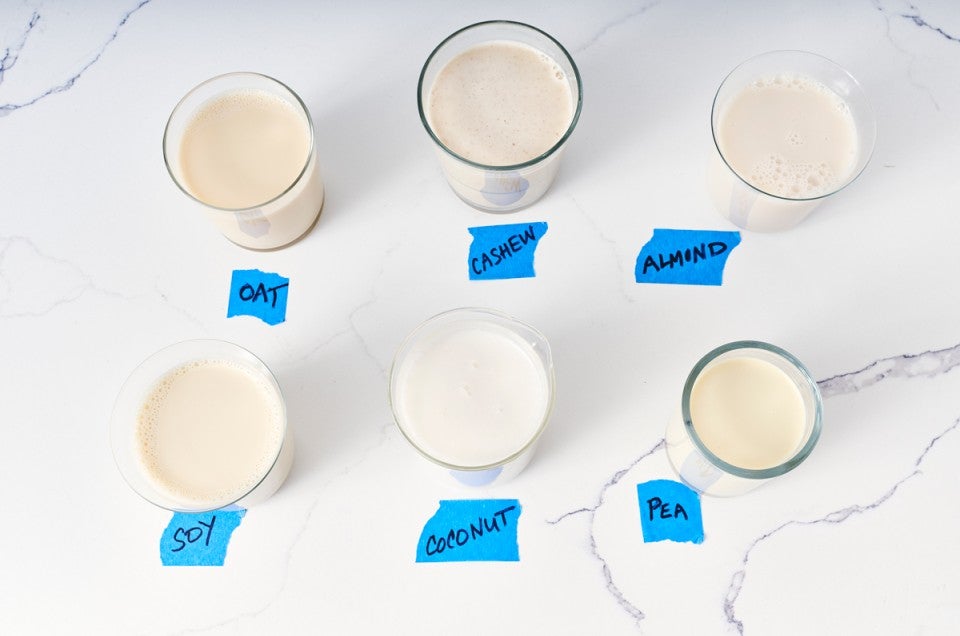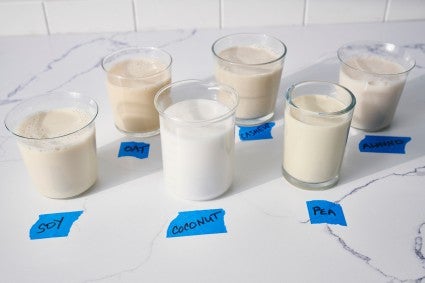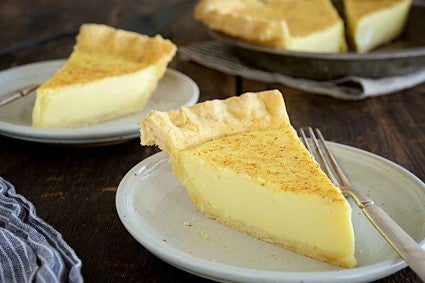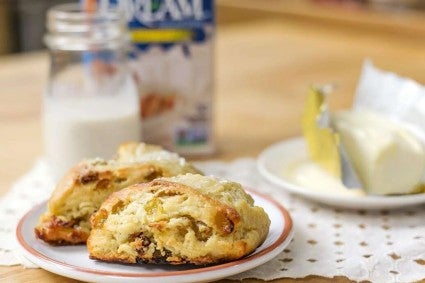Non-dairy milk for baking: What’s the best choice?
One dairy-free milk stands out from the crowd.


Whether you're vegan or simply enjoy non-dairy milk, you probably find yourself wondering at times whether it’s OK to make a 1:1 swap — non-dairy for dairy milk — in any baking recipe. Will that lemon cake be just as tender? Will the milk bread still rise?
The simple answer is yes, you can confidently substitute non-dairy milk for dairy in most baking recipes. But there are some things you should know first.
Dairy milk is between 89% and 90% water, but the remaining 10% includes elements that can be critical to a recipe’s success. The protein, fat, and sugar in milk can affect a baked good’s structure, mouthfeel, flavor, and browning — sometimes almost imperceptibly, but other times in a major way.
There are significant differences in the key nutritional components of the dairy-free milks you’ll find at your supermarket. Most have only a minimal amount of protein, which can play a significant role in the structure of your baked goods. Thankfully, there’s one common dairy-free milk that equals the protein level of cow’s milk: soy.

Soy milk equals dairy milk in protein level (8 grams protein per 8-ounce serving) — an area in which most of the other vegan milks fall far short. Soy milk also matches whole milk closely in terms of viscosity, which can be an important consideration in baking as well: How thick or thin your dough or batter is can make a difference in your baked goods’ rise and structure.
If you’re not a fan of soy milk, don’t despair; whatever non-dairy milk you prefer can work nearly as well as soy in most recipes, from your favorite sandwich bread to a fancy birthday cake. Let’s look at some basic recipe categories, and what you can expect if you substitute almond, oat, or your other dairy-free favorite for regular cow’s milk.
Each of the recipes below features a significant amount of milk, in order to best identify any differences among non-dairy milks. Recipes were tested with the following vegan milks:
The results were evaluated in terms of rise, texture, mouthfeel (richness), flavor, and browning.
Recipe: English Muffin Toasting Bread
Results: All the milks performed well, with soy yielding a loaf most like that made with dairy milk. Other non-dairy milks produced bread that rose higher, due to their dough being noticeably slacker and thus quicker to rise. But those loaves were also prone to crumbling, especially if over-risen; their lack of protein contributed to their less stable structure.
All of the breads were equal in terms of mouthfeel, flavor, and browning.
Recipe: Basic Muffins made with fresh strawberries
Results: All of the vegan milks proved a seamless substitute. Rise, texture, mouthfeel, flavor, and browning were the same.
Recipe: Chef Zeb’s Hot Milk Cake
Results: Because milk plays such a crucial role in hot milk cake (hence the name), you might expect to see a big difference between dairy and dairy-free versions. Yet all of the milks performed similarly: Pea and soy milk yielded cake with a slightly finer texture than that of the other vegan milks, and the oat milk cake browned a bit more. But in terms of rise, mouthfeel, and flavor, there was no noticeable difference among the milks.
Tip: Can you use non-dairy milk in frosting, icing, or glaze? Yes, though you’ll want to consider its viscosity. Because it's typically thinner, you’ll probably need less non-dairy milk than dairy, so use a light hand when following a recipe calling for “enough milk to make the frosting spreadable.”
Recipes: Custard Pie and Pastry Cream
We tested non-dairy milks in two very dairy-heavy pie fillings: custard and cream. We quickly discovered that most dairy-free milks can’t be substituted seamlessly in egg-thickened custards or in flour and/or cornstarch-thickened fillings (e.g., chocolate cream pie filling or pastry cream).
The one exception? Soy milk.
We tested non-dairy milks in baked custard (thickened only with eggs) and pastry cream (aka crème pâtissière, thickened with cornstarch and flour). The results ranged from firm and sliceable to soft and pudding-like to absolute soup. Some vegan milks thickened nicely as they cooked, then fell apart as they cooled (coconut). Some never thickened at all (almond).

Only soy milk yielded a custard or cream that was nearly (though not quite) as thick and sliceable as the original dairy milk version. Oat milk was a worthy second-place finisher: Though the result isn’t sliceable, both custard and crème patisserie made with oat milk hold their shape on your spoon or fork.
If you’re bound and determined to use non-dairy milk other than soy or oat for your egg- and milk-based custard or pastry cream, here are two things you can try:
Finally, if you’re simply looking for a failproof vegan cream pie recipe, you’ll love our No-Bake Vegan Chocolate Pie.

Scones and biscuits seldom call for milk, relying instead on either buttermilk or cream for their liquid. You can make your own “soured milk” to substitute for buttermilk: Stir 1 tablespoon lemon juice or white vinegar into 1 cup non-dairy milk (just choose your favorite, any type will work). Let it rest for about 15 minutes before using. You may notice that dairy-free soured milk doesn’t thicken quite as much, but the result in your baking will be the same.
And if your recipe calls for heavy cream? Substitute full-fat (not “lite”) canned coconut milk, or canned unsweetened coconut cream. You’ll be amazed at how well either of these mimics heavy cream. In the case of coconut cream, you can even whip it into stiff peaks to use as a topping, just as you can dairy cream.
As for cookies, most recipes don’t call for milk. And if they do, it’s a relatively small amount. Any non-dairy milk should work just fine in your favorite cookie recipes.
How do non-dairy milks compare to dairy milk (and one another) in terms of sustainability? Find out here: What's the most environmentally-friendly plant-based milk to bake with?
Cover photo and food styling by Liz Neily.


